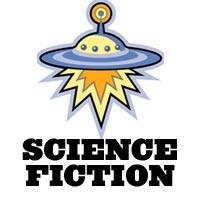Notable Robots or Droids in Sci-Fi Films:
A special subsection has been created on the subject of robots in film.
See:  Robots in Film (a comprehensive illustrated history here). Robots in Film (a comprehensive illustrated history here).
Throughout cinematic history, especially in science-fiction
tales, robots have played a primary role. Robotic characters were chosen,
in part, as a way to probe and examine prototypical humans endowed with anthropomorphic
(but artificial) intelligence or characteristics. Terms related to robots
include:
- robot or 'robotic' is often
used pejoratively, to refer to any device that performs mechanically or
automatically without original thought
- android (or humanoid) refers
to an automaton or artificial man that possesses human features and resembles
a human being
- cyborg (or bionic man/woman)
refers to a human whose body and physiological processes are aided or controlled,
in whole or in part, by electronic or mechanical devices
Robots functioned as either servant-helpers or oppressors
of humanity, portraying the good and evil sides. Herein are examples of various
films with robotic characters:
- Metropolis (1927) - one of the earliest robots (probably
the first) in film, portrayed by Brigitte Helm; constructed and brought
to life by mad scientist Rotwang as a metal android (resembling Star
Wars' C-3PO), to deceptively assume the role of the virtuous hero Maria
(also Helm) - and perform erotic dances
- The Wizard of Oz (1939) - with the Tin Woodsman, actually a robot (lacking a heart)
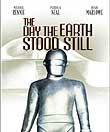 The
Day The Earth Stood Still (1951) - featuring the giant,
all-powerful robot Gort (with a laser-beam behind a helmet-visor),
instructed by alien Klaatu to warn Earth about its destructive
path. Gort demonstrated its power to melt away weapons and tanks,
and to stop the world's electrical power for half an hour; with
the film's famous command to control the enforcer from destroying
Earth: "Gort,
Klaatu barada nikto" The
Day The Earth Stood Still (1951) - featuring the giant,
all-powerful robot Gort (with a laser-beam behind a helmet-visor),
instructed by alien Klaatu to warn Earth about its destructive
path. Gort demonstrated its power to melt away weapons and tanks,
and to stop the world's electrical power for half an hour; with
the film's famous command to control the enforcer from destroying
Earth: "Gort,
Klaatu barada nikto"- Forbidden Planet
(1956) -
with the famous, classic movie robot: the cone-shaped and jukebox-headed
Robby the Robot, built by Dr. Morbius from
plans left by an alien race. Robby was "tinkered together" by
Morbius based on his understanding of Krell technology. [Note: Robby
was reprised in various cameos and appearances, such as Robot B-9 in
the TV show Lost
in Space, in the TV series The Thin Man in 1958, and
in Rod Serling's TV series The Twilight
Zone; also in the films The Invisible Boy (1957), Gremlins
(1984), Earth
Girls Are Easy (1988), and Looney Tunes: Back in Action
(2003)]
- The Colossus of New York (1958) - about a murderous,
Frankenstein-like, hulking, glowing-eyed caped robot
- Alphaville (1965) - the capital of a totalitarian
state, Alphaville, was led by an almost-human computer called Alpha 60
- 2001: A Space Odyssey (1968) - based on Arthur C. Clarke's The Sentinel; it must be noted that
the villainous HAL 9000 computer (voice of Douglas Rain), although appearing
robotic, was not a robot
- THX 1138 (1971) - George Lucas' feature debut film,
with a world ruled by hundreds of identical, black-clad robot enforcement
cops
- Silent Running (1972) - featuring two, beautifully-designed
drones or robots named Huey and Dewey
- Fantastic Planet (1973) - an animated film about
giant humanoid creatures on the futuristic planet Yagam
- Sleeper (1973) -
Woody Allen's satirical comedy about the dystopic future, with
Allen as a health-food store co-owner who woke up in the world
of 2173 after being accidentally cryo-frozen; to disguise himself,
he had to pretend to be a robotic household butler, and later joined
rebels to overthrow "The
Leader" (a disembodied Nose)
- Westworld (1973) and sequel Futureworld (1976) - the original film from writer/director Michael Crichton, about a remote
entertainment park on an island populated with androids, including Yul Brynner
as a beserk gunslinging, black-clad cowboy
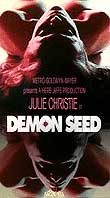 Roboman
(1974) (aka Who? (1975)) - with Joseph Bova as an injured American
government official turned into a cyborg by the Russians Roboman
(1974) (aka Who? (1975)) - with Joseph Bova as an injured American
government official turned into a cyborg by the Russians- The Stepford Wives (1975) - in which housewives
in New England were slowly being tranformed into loving androids; the original
film was remade in 2004
- Demon Seed (1977) - about an artificially-intelligent
supercomputer, dubbed Proteus IV (voice of Robert Vaughn) - "something
more than human, more than a computer. It is a murderously intelligent,
sensually self-programmed non-being." It
was able to take over a house computer control system and a wheelchair
device with a robotic arm (named "Joshua") attached to
it, enabling it to trap, kidnap, hold down, rape, and impregnate
with its "seed" the lady of the house Susan (Julie Christie)
- Star Wars (1977) episodes (from
1977 to 2005) - George Lucas' golden robotic droid C3-PO was patterned after
the robot in Metropolis and Robby the Robot in Forbidden Planet;
also with the barrel-shaped robot R2-D2 that spoke only with electronic
squeals or bleeps, and was capable of short-circuiting with blue flashes
of lightning
- Alien (1979) - one of the
spaceship's crew members, Ash (Ian Holm), was an android; in sequels Aliens
(1986) and Alien 3 (1992), another android named Bishop (Lance
Henrikson) was prominent
- Star Trek: The Motion Picture (1979), its sequels, and the Star Trek Next Generation films
- with androids, such as the white-skinned, yellow-eyed android Commander
Data (Brent Spiner)
- Galaxina (1980) - a science-fiction parody featuring
a sexy android (Playboy Playmate Dorothy Stratten in her last film before
her murder)
- Saturn 3 (1980) - a research scientist couple (Kirk
Douglas and Farrah Fawcett) in space were threatened by a menacing robot
- Android (1982) - in the year
2036, Klaus Kinski (as eccentric scientist Dr. Daniel in a satellite laboratory),
who has already made an illegal android named Max 404, struggled to create
a female android, using escaped convict Maggie as a model
- Blade Runner (1982) - Ridley
Scott's classic cult film, with 'replicants' (androids considered "more
human than human") that were hunted down by 'blade runner' Deckard
(Harrison Ford); one was Rutger Hauer (as Replicant Roy Batty)
- Runaway (1984) - Michael Crichton's techno, sci-fi
action film with robot-hunter Tom Selleck and pretty Cynthia Rhodes as two
cops who must derail attacks by evil, runaway robots sent out by maniacal
Gene Simmons (rock singer from the group KISS)
- The Terminator (1984) and Terminator 2: Judgment Day (1991) - from
director James Cameron, with Arnold Schwarzenegger as an unstoppable, villainous
model T-800 cyborg (with a human exterior and cold metal interior) in the
first film, and a protective T-800 Terminator in the second film battling
a seemingly-indestructible Terminator android composed of liquid metal named
T-1000 (Robert Patrick); followed by director Jonathan Mostow's Terminator
3: Rise of the Machines (2003) with a female Terminator model T-X (Kristanna
Loken)
- D.A.R.Y.L. (1985) - a sci-fi drama about an android
boy (Barret Oliver) named Daryl (Data Analyzing Robot Youth Lifeform)
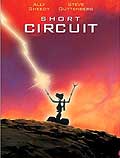 Aliens
(1986) - Bishop, the upgrade, pacifistic, knife-carrying model (portrayed
by Lance Henriksen) from Ian Holm's devious android Ash in the 1979 film,
who was ripped in two by the alien Queen Mother, but kept fighting Aliens
(1986) - Bishop, the upgrade, pacifistic, knife-carrying model (portrayed
by Lance Henriksen) from Ian Holm's devious android Ash in the 1979 film,
who was ripped in two by the alien Queen Mother, but kept fighting- Short Circuit (1986) - about an endearing, adorable,
sophisticated robot known only as "Number 5" that was struck by
lightning and came alive; with a sequel in 1988
- Robocop (1987) - a graphically-violent film featuring
a cyborg, half-human half-robot supercop (Peter Weller); with sequels in
1990 and 1992; the film also featured the stop-motion animated ED-209 robot
- a giant, awkward, top-heavy, failed law enforcement robot
- Cyborg (1989) - a post-apocalyptic tale with Jean
Claude Van Damme as a mercenary who must rescue a beautiful, but abducted
cyborg
- Robot Wars (1993) - set in the year 2041, about
a renegade 'Megarobot' pilot who must defeat a giant robot resurrected and
controlled by evil rival Centros
- Mystery Science Theater 3000: The Movie (1996) -
with robots Tom Servo and Crow T. Robot who provided sarcastic commentary
on This Island Earth
- Bicentennial Man (1999) - based on Isaac Asimov's
short story The Positronic Man (only his second writing adapted for
the screen), featuring Robin Williams as Andrew, a domestic android robot
who craved to become fully human
- Iron Giant (1999) - an animated film about a friendly,
fifty-foot robot (voice of Vin Diesel)
- A.I.: Artificial Intelligence (2001) - Steven Spielberg's
science-fiction fairy tale with Haley Joel Osment as David, a "mecha"
(robot of the future), with a similar plot-line to Disney's Pinocchio
- a CGI/live-action thriller titled I, Robot (2004) - from Australian director Alex Proyas, a futuristic film inspired by the
stories in the 9-part anthology of I, Robot stories from Isaac Asimov
and penned in the 1940s; the premise of the film was that a US Robotics
creation - a robot named Sonny, was uncharacteristically suspected of murder
by Chicago homicide detective Will Smith and a psychologist (Bridget Moynahan),
thereby breaking the First Law of Asimov's Three Laws of Robotics (that "a robot may not injure a human being or, through inaction, allow
a human being to come to harm")
- the adaptation of Douglas Adams' classic wacky sci-fi satire The Hitchhiker's Guide to the Galaxy (2005), with its bubble- or
moon-headed, permanently dour Marvin the Paranoid Robot (Warwick Davis,
voice of Alan Rickman)
Major Action-Sci-Fi Film Hybrids:
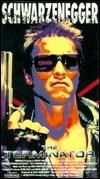 Director/writer
James Cameron brought two views of an apocalyptic, post-nuclear wasteland
to the screen with Arnold Schwarzenegger first playing an action villain,
and then an action hero in two brilliant films: Director/writer
James Cameron brought two views of an apocalyptic, post-nuclear wasteland
to the screen with Arnold Schwarzenegger first playing an action villain,
and then an action hero in two brilliant films:
- the first was a low-budget, intensely exciting film The
Terminator (1984), with a twist on time-travel films, featuring
an indestructible cyborg robot sent back to the 20th century from a distant
future (the year 2029) intent on 'terminating' a woman before she could
give birth to a son - John Connor - who would grow up to lead a rebellion
against the robot's future masters; the film imagined a future in which
robotic machines, aberrant creations of humans, were masters of Earth (echoing
the mythical fear of the Frankenstein films)
- an equally impressive blockbuster sequel was Terminator
2 - Judgment Day (1991) - a film noted for its spectacular "morphing"
through computer-generated special effects; a killing terminator is sent
back in time by Skynet (a 21st century computer warring against the human
race) to destroy the leader of the human resistance as a boy
Lucas' and Spielberg's Contributions:
 [George
Lucas' first feature film was the dystopic thriller THX 1138
(1971),
an atmospheric film about a repressive Orwellian futuristic, dehumanized,
subterranean society that forbade love and sexual intercourse.] By
the late 1970s and early 1980s, films by Lucas and Spielberg consciously
paid tribute to serials of the 1930s, with hero Luke Skywalker,
swooping space battles, imaginative bar creatures in Mos Eisley's
Cantina, revolutionary special effects, Harrison Ford at the controls
of the Millennium Falcon spacecraft, and a vast universe.
Aliens could be more friendly and benevolent, evidenced by loveable
robots (R2D2 and CP-30) and Chewbacca in the popular Star Wars fantasy
space epic "trilogy" - all modern blockbusters. The
first in this space opera trilogy set another standard for action-propelled,
special-effects science-fiction: [George
Lucas' first feature film was the dystopic thriller THX 1138
(1971),
an atmospheric film about a repressive Orwellian futuristic, dehumanized,
subterranean society that forbade love and sexual intercourse.] By
the late 1970s and early 1980s, films by Lucas and Spielberg consciously
paid tribute to serials of the 1930s, with hero Luke Skywalker,
swooping space battles, imaginative bar creatures in Mos Eisley's
Cantina, revolutionary special effects, Harrison Ford at the controls
of the Millennium Falcon spacecraft, and a vast universe.
Aliens could be more friendly and benevolent, evidenced by loveable
robots (R2D2 and CP-30) and Chewbacca in the popular Star Wars fantasy
space epic "trilogy" - all modern blockbusters. The
first in this space opera trilogy set another standard for action-propelled,
special-effects science-fiction:
A low-budget, satirical Star Wars parody was created
by director Ernie Fosselius titled Hardware Wars (1978) - "May
the Farce Be With You" - with characters Princess Anne-droid, Fluke Starbucker,
the Cookie Monster (for Chewbacca), an incomprehensible Darf Nader, Artee-Deco
(a canister vaccuum cleaner), 4-Q-2 (as C3PO), Ham Salad, and space objects-vehicles
such as toasters, irons and mixers.
In 1999, Lucas backpedaled and created the first film in the
epic saga, quickly followed by other prequels:
[Note: Another Star Wars film was released 10
years later in 2015, Star Wars: Episode VII - The Force Awakens
(2015).
It was the first part of a sequel trilogy of Star
Wars (Episodes:
VII, VIII and IX). It was the first of the Star
Wars films without series creator George Lucas' involvement,
and the first film to be released following Disney's 2012 acquisition
of LucasFilm. Many box-office records were broken almost immediately.
See Star Wars Films: Reviewed
and Ranked.]
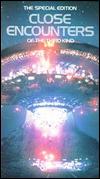 The
preceding years of fearful dystopias and menacing aliens were dismissed by
Steven Spielberg's pre-E.T. Close Encounters of the
Third Kind (1977). It was an enchanting sci-fi film filled with awe
and wonder at numerous appearances of UFO spaceships, a mother ship, and the
first communication between earthlings (led by real outer-limits researcher
Jacques Vallee, played by Francois Truffaut) and friendly extra-terrestrial
aliens - conveyed with bursts of sound and light. Spielberg followed Close
Encounters in the early 1980s with one of the most endearing and charming
films about benign extraterrestrials ever made - E.T.: The Extra-Terrestrial (1982). The
preceding years of fearful dystopias and menacing aliens were dismissed by
Steven Spielberg's pre-E.T. Close Encounters of the
Third Kind (1977). It was an enchanting sci-fi film filled with awe
and wonder at numerous appearances of UFO spaceships, a mother ship, and the
first communication between earthlings (led by real outer-limits researcher
Jacques Vallee, played by Francois Truffaut) and friendly extra-terrestrial
aliens - conveyed with bursts of sound and light. Spielberg followed Close
Encounters in the early 1980s with one of the most endearing and charming
films about benign extraterrestrials ever made - E.T.: The Extra-Terrestrial (1982).
The 90s: A Mix of Action and/or Sophisticated Story-Telling
By the 90s, sophisticated digital effects were overtaking
science fiction films, and creating spectacular and monstrous creatures such
as the living dinosaurs in Spielberg's Jurassic Park (1993), The
Lost World: Jurassic Park (1997), and Jurassic Park III (2001);
the female alien invader in Species (1995), the giant marauding bugs
in Starship Troopers (1997), and the bulbous-headed aliens in Tim Burton's
alien-invasion spoof Mars Attacks! (1996). The sci-fi alien invasion
comedies Men in Black (1997) and Men in Black II (2002) were
remarkably successful films that combined both special effects and great acting
from its two leads Will Smith and Tommy Lee Jones.
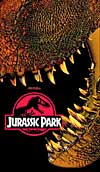 Demolition
Man (1993) pitted 1990s cyrogenically-defrosted LA cop-hero John Spartan
(Sylvester Stallone), after release in the year 2032 from cyro-prison in the
megapolis of San Angeles, to combat another defrosted individual -- violent
psychopath Simon Phoenix (Wesley Snipes - with blonde hair). Wolfgang Petersen's Outbreak (1995), released at the height of the AIDS crisis with additional
fears of bioterrorism, was a traditional disaster thriller about the pervasive
spread of a killer African virus. The ultra-patriotic
sci-fi epic Independence Day (1996) by director Roland Emmerich told
of the extra-terrestrial invasion of the world with the destruction of the
White House as an opener. The roller-coaster action film, a summer blockbuster
with stunning, thrill-ride, Oscar-winning special effects, was a return to
the themes of disaster epics of the
1970s and the alien-invasion content of 50s science fiction. Demolition
Man (1993) pitted 1990s cyrogenically-defrosted LA cop-hero John Spartan
(Sylvester Stallone), after release in the year 2032 from cyro-prison in the
megapolis of San Angeles, to combat another defrosted individual -- violent
psychopath Simon Phoenix (Wesley Snipes - with blonde hair). Wolfgang Petersen's Outbreak (1995), released at the height of the AIDS crisis with additional
fears of bioterrorism, was a traditional disaster thriller about the pervasive
spread of a killer African virus. The ultra-patriotic
sci-fi epic Independence Day (1996) by director Roland Emmerich told
of the extra-terrestrial invasion of the world with the destruction of the
White House as an opener. The roller-coaster action film, a summer blockbuster
with stunning, thrill-ride, Oscar-winning special effects, was a return to
the themes of disaster epics of the
1970s and the alien-invasion content of 50s science fiction.
Two blockbuster Hollywood films released in the summer of
1998 portrayed the threat of Earth-threatening asteroids: Mimi Leder's character-driven
sci-fi action film Deep Impact (1998) (Tagline: Heaven and Earth are
about to collide), with Robert Duvall as an astronaut heading up a government
mission in outer space to destroy the comet; and Michael Bay's Armageddon
(1998) (Tagline: It's Closer Than You Think), with Bruce Willis and his
core drilling team called to thwart the space rock by the use of nuclear weapons.
'Virtual Reality' Sci-Fi Films:
Science-fiction films could easily
portray a world in which reality was unsure, unreliable, dreamlike,
virtual, or non-existent. VR (or virtual reality) films began in
the early 80s, and really blossomed in the 1990s and 2000s. The blurring
of reality with 'virtual', look-alike, or fake universes or worlds
created by 'virtual reality', computer simulations, or imagination
itself fascinated various film-makers. The first VR film was reportedly
the sci-fi western
Welcome to Blood City (1977). In the film, five strangers
awakened in the countryside with no memory of their past, with only
an ID explaining that they were convicted murderers. Sheriff
Frendlander (Jack Palance) brought them to
the western town of Blood City - where they were forced to either
become enslaved, or try to take a top place in society by killing
an older unarmed resident. In the film's sci-fi twist, it was
soon revealed that they were in a VR game, created by technicians
Lyle (John Evans) and Katherine (Samantha Eggar), who were trying
to identify their skills and possibly select them as potential elite
killers for future combat.
The revolutionary, landmark Disney cult film TRON
(1982),
with its astounding CGI and computer animation,
was one of the first films to visualize another world. It also took
advantage of the video-gaming craze of the early 1980s. In the story
(director Steven Lisberger’s
live-action debut), video-game arcade owner/hacker Kevin Flynn (Jeff
Bridges) was transported inside a mainframe computer world (after
being transformed by an experimental matter transmutation program
into data bits). Inside the beautifully-visualized world dominated
by an evil operating system with a giant Lego head, the software-based
humanoid found an action-oriented, neon-colored video-game in which
he had to compete against an evil boss who had metamorphosed into
another video-game character. [The film was remade decades later
as the long-awaited sequel TRON:
Legacy (2010). Jeff Bridges reprised his role as hacker Flynn
and as his ageless, power-hungry computer avatar, Clu.]
Director and visual effects pioneer Douglas Trumbull's
final Hollywood feature film was Brainstorm (1983), notable
as being the last film for Natalie Wood (who died of drowning during
production), and one of the earliest films about virtual reality.
Scientist Dr. Michael Brace (Christopher Walken) and his assistant
Lillian Reynolds (Louise Fletcher) created a unique communications
"Brainstorm" device that could record the visual, aural, sensory
and emotional experiences of one's brain with a headset and sensor
chips - and allow playback by another person to share the VR experience.
The film's main attraction was the visceral thrill of the playback
of an orgasmic sexual experience (on a continuous loop), and also
of a heart-attack and entrance into the after-life.
In Alien
Intruder (1993),
set in the futuristic year of 2022, an evil, extra-terrestrial computer
virus (in the form of beautiful Tracy Scoggins) intruded itself
into the thoughts of the crew of the spaceship USS Presley.
The sci-fi VR horror-thriller
Brainscan (1994) featured the tagline: "Goodbye Reality! Welcome
Virtual Reality!" Video villain Trickster (T. Ryder Smith) appeared
in an interactive computer game called "Brainscan" - within a computer
video screen. The "ultimate experience" horror game was available to
be viewed on 4-CD-ROM discs. It was ordered by 16 year-old misfit,
disenfranchised loner teen Michael Bryer (Edward Furlong), who viewed
the first disc "Death by Design." It was a disturbing but exciting
snuff film that featured the VR experience of a murder from the killer's
POV. The disembodied Trickster then encouraged Bryer to engage in gruesome,
violent thrills by becoming the killer - to his own horror.
Johnny
Mnemonic (1995) was a derivative adaptation of scriptwriter William
Gibson's own cyberpunk short story, and a Keanu Reeves-precursor
to The Matrix (1999), about
a courier with downloaded information in his data-packed head who
had to transport the top-secret data from China to New Jersey. And
in director Brett Leonard's (known for the ground-breaking The
Lawnmower Man (1992))
crime sci-fi-thriller Virtuosity
(1995) set in 1999,
former disgraced L.A. detective Parker Barnes (Denzel Washington)
(in jail for murdering the killer of his family, but on parole)
pursued invincible opponent Sid 6.7 (Russell Crowe), a synthetic
killer android (with composited evil traits of Hitler, Charles Manson
and other serial killer felons), through in a VR training
program for cops. Threatened with the shut-down of the failed testing
program, Sid's deranged software creator gave mass-murderer Sid a
real-world body.
Director Kathryn Bigelow's dystopic tech-noir Strange
Days (1995) opened with an illicit 'playback clip' (a "snuff" clip
called a 'blackjack') of a failed robbery attempt of a Chinese restaurant
by masked criminals. The clip was recorded (or "wired")
directly from a head device called a 'squid' (short for Superconducting
Quantum Interference Device) connecting into the cerebral cortex ("It's
pure and uncut, straight from the cerebral cortex"). Sleazy ex-vice squad
cop and peddler of illegal software clips Lenny Nero (Ralph Fiennes)
often watched the playback of clips of sexy ex-girlfriend Faith Justin
(Juliette Lewis). However, there were also more disturbing contraband
snuff clips - of brutal rape, strangulation and death.
Human freedoms were almost non-existent in the world of genetic
monitoring and engineering found in Andrew Niccol's Gattaca (1997).
Peter Weir's fanciful The Truman Show (1998) satirized how TV ratings
dictated the imprisonment and victimization of a show's star by the unrestricted
media, all for the unethical purpose of sustaining a hit TV show. [It was
partially inspired by Albert Brooks' satirical media comedy Real Life (1979) (based on PBS' mini-series An American Family in 1973).] Then, director
Ron Howard followed with a similar but lackluster EDtv (1999).
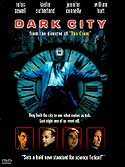 Alex
Proyas' visually-stunning and visionary sci-fi noir Dark City
(1998) (Tagline: "A world where the night never ends. Where man
has no past. And humanity has no future"), one of the best films
to effectively twist unreal reality, starred Rufus Sewell as a man
with memory problems living and pursued in a nightmarish, retro
40s-style futuristic world managed by malevolent, underground alien
beings called Strangers. The aliens possessed telekinetic powers
that could stop time and alter reality. Alex
Proyas' visually-stunning and visionary sci-fi noir Dark City
(1998) (Tagline: "A world where the night never ends. Where man
has no past. And humanity has no future"), one of the best films
to effectively twist unreal reality, starred Rufus Sewell as a man
with memory problems living and pursued in a nightmarish, retro
40s-style futuristic world managed by malevolent, underground alien
beings called Strangers. The aliens possessed telekinetic powers
that could stop time and alter reality.
Writers/directors Andy and Larry Wachowski's hyperkinetic The
Matrix (1999) (Tagline: "Be afraid of the future") illustrated
how to superbly combine amazing action scenes with an intelligent
story-line (a modern-day updating of the man vs. machine tale).
It examined the nature of reality in the external world - seemingly
uncertain, in which reality was a computer simulation, and the
actual Earth was scorched. The explosive and successful trilogy
featured sensational special/visual effects, with the same cast
in each offering (Keanu Reeves as Neo, Carrie-Anne Moss as Trinity,
Laurence Fishburne as Morpheus, and Hugo Weaving as Agent Smith):
Josef Rusnak's tech-noir sci-fi film The Thirteenth
Floor (1999) (Tagline: Question reality. You can go there
even though it doesn't exist) blended both The Truman Show
(1998) and The Matrix (1999) with
its blurring of the lines between reality and virtual or artificial
reality, in its contrast of mid-1930s and late 1990s Los Angeles.
Another 'virtual reality' film in the same year, David Cronenberg's
cautionary and plot-twisting eXistenZ (1999) (Tagline: Play
it. Live it. Kill for it), explored how a 'virtual reality' game
could tap into a person's mind. Steven Spielberg's cyber-noirish
action and sci-fi thriller Minority Report (2002), set
in the futuristic year of 2054 from an adapted Philip K. Dick story,
starred Tom Cruise as a cop preventing pre-committed murders.
In the science-fiction related romance Eternal Sunshine of
the Spotless Mind (2004) with a
script by Charlie Kaufman, Jim Carrey had his memories of his romance
with an ex-girlfriend (Kate Winslet) wiped clean - until he abruptly
changed his mind.
The sci-fi thriller Gamer (2009) was a hyper-kinetic
action film where real-life and video-games were merged, with the
creation of an ultimate interactive video game dubbed "Slayers."
17 year-old game expert Simon (Logan Lerman) was able to miraculously
defeat other opponents in the game - using a real-life video-game
avatar named Kable (Gerard Butler). Kable was a death-row inmate
placed unwillingly into the VR playing field of the game, while also
recruited to escape the dehumanizing game and defeat the game's corporate
leader Ken Castle (Michael C. Hall), a reclusive billionaire. In
another sci-fi thriller in the same year, the thought-provoking Surrogates
(2009)
was set in a futuristic utopian world. There, artificial robotic,
avatars or life-forms substituted for living people as a fail-safe
mechanism. The surrogates were perfect, 3-dimensional mechanical
(or cloned) representations of their original humans - who remained
safely at home and controlled the actions of the beings with their
minds. Bruce Willis and Radha Mitchell portrayed two FBI agents,
Tom Greer and Peters, who
were forced to investigate a strange double homicide in which the
destruction of two surrogates also resulted in the deaths of their
human hosts. And James Cameron's Avatar (2009) was the ultimate
fantasy sci-fi film, in which paraplegic Marine Jake Sully (Sam Worthington)
took part in a mission to the distant world of Pandora, inhabited
by the giant, indigenous humanoid race of Na'vi. With the aid of
a sophisticated Avatar program, Jake was linked to a genetically-bred,
human-Na'vi hybrid, so that within his avatar's blue-skinned
body, he could function as a Na'vi native and breathe the hostile
air of the planet.
In the action-oriented, time-travel thriller Source
Code (2011),
a variation on Groundhog Day (1993), Jake Gyllenhaal starred
as Captain Colter Stevens - tasked to participate in a top-secret
government experiment called "Source Code." To identify a threatening
Chicago commuter train bomber, he repeatedly entered the body of
one of the train's male passengers to relive his life during the
8 minutes before he was killed on the exploding train. As Stevens
continually repeated the tense mission, he attempted to gather enough
clues to prevent a massive terrorist attack.
And
in the thought-provoking sci-fi cyber-thriller Transcendence
(2014),
eccentric yet charismatic AI science researcher/teacher Dr. Will
Caster (Johnny Depp) was fatally shot by an extremist anti-technology
group of radicals known as RIFT (Revolutionary Independence From
Technology). After his consciousness was uploaded into a super-computer
to save him, a phenomenon known as Whole Brain Emulation, Caster
returned via a hologram. However, the fear emerged that he would
become a dangerous megalomaniac force when his capacities vastly
expanded and he created an army of nanomites in his desert HQ to
aid his quest.
Animated Science Fiction Films At the Turn of the Century:
From the mid-1990s to the early part of the next century,
a number of animated films contained
science-fiction themes, such as:
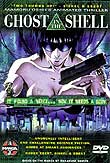 the
cyberpunk Japanese anime Ghost in the Shell (1996) was set
in the year 2029 in a world where all crime was conducted in cyberspace
and led by a master hacker called the Puppet Master; a specialized police
force in the Asian metropolis named Newport's Section Nine directed an investigation
to cope with the problem, headed by female android-cyborg undercover officer
the Major, Motoko Kusanagi -- a babe-like Playboy centerfold cross-bred
with the Terminator and the Bladerunner -- who was also searching for her
own identity the
cyberpunk Japanese anime Ghost in the Shell (1996) was set
in the year 2029 in a world where all crime was conducted in cyberspace
and led by a master hacker called the Puppet Master; a specialized police
force in the Asian metropolis named Newport's Section Nine directed an investigation
to cope with the problem, headed by female android-cyborg undercover officer
the Major, Motoko Kusanagi -- a babe-like Playboy centerfold cross-bred
with the Terminator and the Bladerunner -- who was also searching for her
own identity- The Iron Giant (1999), about
a friendly and benevolent robot
- the space adventure saga Titan
A.E. (2000)
- the Japanese anime Pokemon the
Movie: 2000 (2000)
- the fantasy Jimmy Neutron: Boy
Genius (2001) with green alien Yokians
- Atlantis: The Lost Empire (2001)
- the updated space adventure Treasure
Planet (2002)
- the first feature-length CGI film Final
Fantasy: The Spirits Within (2002), in which a
female scientist in the year 2065, Dr. Aki Ross searched for a cure to ward
off infection by alien phantoms
- Lilo & Stitch (2002) about a young girl's friendship for a blue extra-terrestrial, with six Elvis Presley songs on its soundtrack
|
